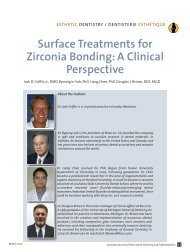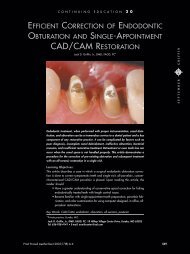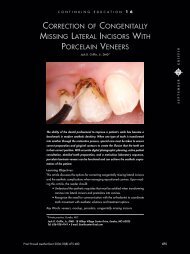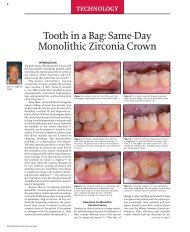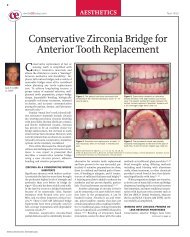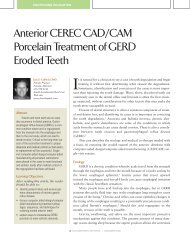use of digital photography to improve composite resin selection and ...
use of digital photography to improve composite resin selection and ...
use of digital photography to improve composite resin selection and ...
Create successful ePaper yourself
Turn your PDF publications into a flip-book with our unique Google optimized e-Paper software.
CONTINUING EDUCATION 11<br />
USE OF DIGITAL PHOTOGRAPHY TO<br />
IMPROVE COMPOSITE RESIN SELECTION<br />
AND MATERIAL PLACEMENT<br />
Jack D. Griffin, Jr, DMD*<br />
GRIFFIN<br />
20<br />
6<br />
JULY<br />
Digital <strong>pho<strong>to</strong>graphy</strong> has become essential in modern dentistry. In addition <strong>to</strong> providing<br />
enhanced communication between collaborating dentists, high-quality imagery<br />
can also be a valuable diagnostic <strong>to</strong>ol in direct <strong>composite</strong> procedures. There<br />
are many <strong>composite</strong> systems currently available with various opacities, shades,<br />
tints, <strong>and</strong> physical properties, which can replicate almost any natural situation. As<br />
advances in material science have <strong>improve</strong>d the performance <strong>of</strong> <strong>composite</strong> <strong>resin</strong>s,<br />
it is the skill <strong>of</strong> the clinician that primarily influences the res<strong>to</strong>rative outcome. The<br />
greatest obstacles lie in determining where <strong>to</strong> layer the various <strong>composite</strong>s <strong>and</strong><br />
envisioning the final result prior <strong>to</strong> placement. Digital pho<strong>to</strong>graphs taken prior <strong>to</strong><br />
<strong>and</strong> during treatment may assist the practitioner in shade <strong>selection</strong> <strong>and</strong> <strong>composite</strong><br />
layering for natural-looking res<strong>to</strong>rations.<br />
Learning Objectives:<br />
This article presents a case in which <strong>digital</strong> pho<strong>to</strong>graphs assisted in the shade<br />
<strong>selection</strong> for a direct <strong>composite</strong> procedure. Upon completion <strong>of</strong> this article, the<br />
reader should:<br />
• Recognize the benefits <strong>of</strong> capturing high-quality images prior <strong>to</strong> <strong>and</strong> during<br />
a procedure.<br />
• Be aware <strong>of</strong> how <strong>digital</strong> pho<strong>to</strong>graphs can assist in <strong>composite</strong> shade <strong>and</strong><br />
layering technique <strong>selection</strong>.<br />
Key Words: : direct <strong>composite</strong> <strong>resin</strong>, <strong>digital</strong> <strong>pho<strong>to</strong>graphy</strong>, shade <strong>selection</strong>,<br />
aesthetics<br />
*Private practice, Eureka, Missouri.<br />
Jack D Griffin, Jr, DMD, Eureka Smile Center, 18 Hill<strong>to</strong>p Village Center Drive, Eureka,<br />
MO 63025<br />
Tel: 636-938-4141 • E-mail: Esmilecenter@aol.com<br />
Pract Proced Aesthet Dent 2008;20(6):359-364 359
Practical Procedures & AESTHETIC DENTISTRY<br />
Contemporary <strong>composite</strong> <strong>resin</strong>s, available in natural<br />
<strong>to</strong>oth shades <strong>and</strong> with favorable optical characteristics<br />
<strong>and</strong> clinical performance, provide practitioners with<br />
res<strong>to</strong>rative materials that are increasingly predictable for<br />
<strong>use</strong> in operative dental procedures. Whereas material<br />
properties were once the challenging aspect <strong>of</strong> direct<br />
<strong>resin</strong> res<strong>to</strong>rations, the diagnostic ability <strong>and</strong> clinical<br />
experience <strong>of</strong> the opera<strong>to</strong>r are now the primary determinants<br />
<strong>of</strong> res<strong>to</strong>rative success. 1 Pho<strong>to</strong>graphic evaluation<br />
<strong>of</strong> the patient’s dentition, prior <strong>to</strong> <strong>and</strong> during direct <strong>composite</strong><br />
placement, can aid the clinician in identifying <strong>and</strong><br />
replicating the ana<strong>to</strong>my <strong>of</strong> the natural <strong>to</strong>oth or teeth—<br />
thereby improving the precision <strong>of</strong> the res<strong>to</strong>rations.<br />
When selecting a <strong>composite</strong> system (eg, Filtek<br />
Supreme, 3M ESPE, St. Paul, MN; Four Seasons, Ivoclar<br />
Vivadent, Amherst, NY; Esthet-X, Dentsply Caulk, Milford,<br />
DE), it is important <strong>to</strong> consider those with multiple opacities<br />
<strong>and</strong> various shades, <strong>and</strong> the practitioner must have<br />
a plan as <strong>to</strong> where <strong>and</strong> in what quantities each material<br />
must be placed. 2 The currently available materials <strong>of</strong>fer a<br />
variety <strong>of</strong> <strong>composite</strong> particle filler sizes <strong>and</strong> shapes that<br />
affect res<strong>to</strong>ration strength <strong>and</strong> polishability <strong>and</strong>, when<br />
their indications are respected, can replicate almost any<br />
natural situation. 3-6 A single, monochromatic <strong>composite</strong><br />
may provide the patient with a serviceable res<strong>to</strong>ration;<br />
<strong>to</strong>oth color nuances, patient preference, or clinician<br />
conviction, however, may warrant a more detailed <strong>and</strong><br />
precise res<strong>to</strong>ration. 7,8<br />
Polychromatic layering <strong>of</strong> <strong>composite</strong> <strong>resin</strong> enables<br />
the clinician <strong>to</strong> effectively recreate the innate properties<br />
<strong>of</strong> the <strong>to</strong>oth structures, provided the material characteristics<br />
<strong>and</strong> proper layering techniques are unders<strong>to</strong>od. 9<br />
By coupling common pho<strong>to</strong>graphic techniques with<br />
an underst<strong>and</strong>ing <strong>of</strong> these varying opacities <strong>and</strong> tints,<br />
<strong>composite</strong> res<strong>to</strong>rations with natural detail may be created.<br />
9 The greatest obstacles lie in determining where <strong>to</strong><br />
place the various <strong>composite</strong>s <strong>and</strong> envisioning the final<br />
result prior <strong>to</strong> placement. In a Class IV case, there are<br />
<strong>of</strong>ten variances in <strong>to</strong>oth colors, opacities, <strong>and</strong> texture<br />
that make material choice <strong>and</strong> placement a challenge<br />
for the practitioner. 10 Digital pho<strong>to</strong>graphs represent an<br />
efficient method for the clinician <strong>to</strong> plan, deliver, <strong>and</strong><br />
enhance such res<strong>to</strong>rations. 11 As highlighted in the following<br />
technique, consultation using preoperative pho<strong>to</strong>graphic<br />
images can provide the clinician with the vision<br />
needed <strong>to</strong> complete these res<strong>to</strong>rations.<br />
Figure 1. Preoperative view <strong>of</strong> a patient with a 14-year-old <strong>composite</strong><br />
res<strong>to</strong>ration that no longer satisfied her aesthetic dem<strong>and</strong>s.<br />
Figure 2. A high-resolution, magnified image can yield a greater<br />
sense <strong>of</strong> <strong>to</strong>oth character when examined away from opera<strong>to</strong>ry<br />
distractions.<br />
With only a few images, <strong>and</strong> with less time than is<br />
normally required for the assistant <strong>to</strong> explain the procedure<br />
<strong>to</strong> the patient, <strong>digital</strong> images can be referenced <strong>and</strong><br />
a res<strong>to</strong>ration prescription quickly established. Following<br />
placement, similar images can be taken, non-distracted<br />
evaluation can be accomplished on a moni<strong>to</strong>r, <strong>and</strong> a<br />
systematic outline for res<strong>to</strong>ration enhancement can then<br />
be created. In the author’s experience, these pho<strong>to</strong>graphic<br />
steps enhance the res<strong>to</strong>ration, precision, <strong>and</strong> speed.<br />
Preoperative Blueprint Pho<strong>to</strong>graphy<br />
In order <strong>to</strong> determine the true color <strong>and</strong> character <strong>of</strong><br />
a <strong>to</strong>oth, distractions that can conf<strong>use</strong> the eye must be<br />
eradicated. These distractions may be extraoral (eg,<br />
opera<strong>to</strong>ry lighting, patient position, <strong>of</strong>fice commotion) or<br />
360 Vol. 20, No. 6
Griffin<br />
Figure 3. Removing s<strong>of</strong>t-tissues from the image with pho<strong>to</strong>graphic<br />
editing s<strong>of</strong>tware may further enhance observation.<br />
The f/s<strong>to</strong>p adjustment dictates the amount <strong>of</strong> light<br />
entering the camera during the flash <strong>and</strong> provides an<br />
accurate control <strong>of</strong> the light reflected back from the<br />
<strong>to</strong>oth. Generally, this camera setting, along with proper<br />
flash <strong>and</strong> lens usage, can provide a detailed view <strong>of</strong><br />
<strong>to</strong>oth character.<br />
Multiple <strong>digital</strong> pho<strong>to</strong>graphs may be captured,<br />
loaded on a computer, <strong>and</strong> analyzed effectively <strong>and</strong><br />
efficiently. A consulting room, where the lights can be<br />
dimmed <strong>and</strong> a large moni<strong>to</strong>r can be viewed, may be<br />
the ideal place <strong>to</strong> analyze treatment images. If this is<br />
not available, any large moni<strong>to</strong>r where the clinician can<br />
evaluate the images without distraction may be beneficial<br />
in analyzing the case. It is the author’s assertion that<br />
these few minutes may increase the accuracy <strong>of</strong> <strong>composite</strong><br />
<strong>selection</strong> <strong>and</strong> reduce the trial <strong>and</strong> error involved<br />
with material placement.<br />
Figure 4. Various <strong>composite</strong>s were tested <strong>to</strong> determine which material<br />
would deliver the desired opacity<br />
intraoral (eg, s<strong>of</strong>t tissue color, shadows, unnatural <strong>to</strong>oth<br />
lighting). Lighting, fatigue, influence <strong>of</strong> other tissues, <strong>and</strong><br />
bias <strong>to</strong>wards certain shades are all fac<strong>to</strong>rs that must be<br />
overcome when focusing on the patient’s needs. Wellcomposed<br />
images that may be reviewed on a large moni<strong>to</strong>r<br />
away from treatment room distractions can ensure that<br />
an accurate plan is formulated.<br />
For single-<strong>to</strong>oth shade matching, light control <strong>and</strong><br />
<strong>to</strong>oth proximity are critical elements <strong>to</strong> be considered.<br />
The most important fac<strong>to</strong>r in a quality image worthy <strong>of</strong><br />
color <strong>and</strong> incisal character evaluation is one in which<br />
light control is excellent. An overexposed image is essentially<br />
<strong>use</strong>less for <strong>to</strong>oth color <strong>and</strong> character evaluation.<br />
Images in the following case were captured with<br />
an SLR <strong>digital</strong> camera in aperture priority “A” mode.<br />
Case Presentation<br />
A 45-year-old female patient presented with a fractured<br />
central incisor <strong>and</strong> a <strong>composite</strong> res<strong>to</strong>ration that had<br />
been placed by the author—with the intent <strong>of</strong> providing<br />
more definitive treatment at a later date—14 years<br />
previously. The res<strong>to</strong>ration was a single-shaded hybrid<br />
<strong>composite</strong> that had served all functional purposes, but was<br />
unacceptable by <strong>to</strong>day’s aesthetic st<strong>and</strong>ards regarding<br />
staining, wear, <strong>and</strong> unnatural character (Figure 1). 12<br />
Extraoral <strong>and</strong> intraoral images were captured<br />
with a 6.1 megapixel <strong>digital</strong> SLR camera, a 105-mm<br />
macro lens, <strong>and</strong> a macro speedlight (ie, Nikon D70,<br />
Nikkor 105mm macrolens, SB-29s, Nikon, Rutherford,<br />
NJ). Extraoral <strong>and</strong> wide intraoral images were taken<br />
<strong>to</strong> document the preoperative condition <strong>of</strong> the patient,<br />
but not necessarily <strong>to</strong> aid in <strong>composite</strong> placement.<br />
Despite the diligent effort by the staff <strong>to</strong> select shades,<br />
it was difficult <strong>to</strong> precisely match colors <strong>and</strong> tints<br />
directly on the patient due <strong>to</strong> distractions that complicated<br />
proper evaluation.<br />
Maximum close-up images were thus captured for<br />
thorough evaluation <strong>of</strong> <strong>to</strong>oth color, opacity, <strong>and</strong> incisal<br />
character. Gingival retrac<strong>to</strong>rs were placed <strong>to</strong> prevent<br />
shadows during the exposure, <strong>and</strong> a contras<strong>to</strong>r (ie,<br />
Pho<strong>to</strong>Med, Van Nuys, CA) was held behind the teeth <strong>to</strong><br />
decrease the unnatural lighting <strong>of</strong> the teeth from behind<br />
during the flash. The <strong>digital</strong> pho<strong>to</strong>graphs were loaded<br />
in<strong>to</strong> a computer <strong>and</strong> viewed on a large moni<strong>to</strong>r, where<br />
P PAD 361
Practical Procedures & AESTHETIC DENTISTRY<br />
in <strong>to</strong>oth color, tints, <strong>and</strong> variations in opacity were noted.<br />
The maximum zoom, combined with proper lighting control,<br />
provided an excellent means <strong>of</strong> determining material<br />
placement (Figure 2).<br />
To further ensure an accurate res<strong>to</strong>rative prescription,<br />
non<strong>to</strong>oth tissues that may distract the clinician’s<br />
eye were removed using a <strong>digital</strong> imaging s<strong>of</strong>tware<br />
(ie, Pho<strong>to</strong>Shop, Adobe, San Jose, CA) (Figure 3). The<br />
adjusted image was displayed in the treatment room<br />
according <strong>to</strong> a written color prescription similar <strong>to</strong> those<br />
provided <strong>to</strong> a dental labora<strong>to</strong>ry for the fabrication <strong>of</strong> an<br />
indirect res<strong>to</strong>ration. This evaluation occurred while the<br />
assistant mocked up <strong>composite</strong>s <strong>of</strong> varying shades <strong>and</strong><br />
opacities <strong>to</strong> confirm the res<strong>to</strong>ration prescription.<br />
Composite Layering With Digital Images<br />
The existing <strong>composite</strong> was removed with a course diamond,<br />
<strong>and</strong> an irregular 3-mm <strong>to</strong> 4-mm bevel was placed<br />
<strong>to</strong> create a finish line that would conceal the fracture<br />
line following direct <strong>resin</strong> buildup. A <strong>composite</strong> system<br />
with three different opacities (ie, dentin, enamel, <strong>and</strong><br />
incisal) <strong>and</strong> cus<strong>to</strong>mization tints (ie, Renamel, Cosmedent,<br />
Chicago, IL) was selected, <strong>and</strong> confirmation <strong>of</strong> <strong>composite</strong><br />
shades <strong>and</strong> opacities were performed. To accomplish<br />
this, the clinician placed the <strong>resin</strong> material on a nonbonded<br />
<strong>to</strong>oth <strong>and</strong> cured it (Figure 4). The trial materials<br />
were then removed, the <strong>to</strong>oth was etched with a 37%<br />
phosphoric acid, <strong>and</strong> a light-cured bonding agent was<br />
applied <strong>and</strong> air thinned (Figure 5).<br />
Using a more opaque <strong>composite</strong>, the first dentin<br />
layer was placed in an irregular form with lobes, using<br />
the <strong>digital</strong> <strong>pho<strong>to</strong>graphy</strong> as a guide. This layer would<br />
provide the majority <strong>of</strong> the res<strong>to</strong>ration’s strength, impart<br />
basic internal color, form the internal <strong>to</strong>oth lobes, <strong>and</strong><br />
conceal most <strong>of</strong> the res<strong>to</strong>ration/<strong>to</strong>oth junction (Figure<br />
6). The microhybrid <strong>resin</strong> was <strong>use</strong>d in order <strong>to</strong> <strong>improve</strong><br />
the res<strong>to</strong>ration’s ability <strong>to</strong> withst<strong>and</strong> intraoral forces; this<br />
layer would subsequently be covered with a micr<strong>of</strong>ill<br />
<strong>resin</strong> <strong>to</strong> instill a natural finish for the res<strong>to</strong>ration. 13,14 The<br />
dentin layer was undercon<strong>to</strong>ured on the facial aspect <strong>to</strong><br />
ensure that it remained 0.5 mm <strong>to</strong> 1 mm undercon<strong>to</strong>ured<br />
after final shaping.<br />
A low-opacity incisal layer, with 1 mm <strong>to</strong> 2 mm <strong>of</strong><br />
overextension, was placed <strong>to</strong> res<strong>to</strong>re the incisal edge<br />
(Figure 7). In order <strong>to</strong> build the innate characterizations <strong>of</strong><br />
the <strong>to</strong>oth, the material was placed in an irregular manner,<br />
Figure 5. Following removal <strong>of</strong> the trial materials, an irregular,<br />
long bevel was <strong>use</strong>d <strong>to</strong> facilitate acid etching <strong>and</strong> placement <strong>of</strong> a<br />
bonding agent.<br />
Figure 6. A <strong>composite</strong> with dentin opacity was <strong>use</strong>d <strong>to</strong> form the<br />
majority <strong>of</strong> the lingual aspect <strong>and</strong> was intentionally left undercon<strong>to</strong>ured<br />
prior <strong>to</strong> polymerization.<br />
Figure 7. A low-opacity incisal <strong>composite</strong> was placed with a slight<br />
overextension <strong>to</strong> complete the length <strong>of</strong> the res<strong>to</strong>ration <strong>and</strong> res<strong>to</strong>re<br />
the incisal edge.<br />
362 Vol. 20, No. 6
Griffin<br />
Figure 8. Various, cus<strong>to</strong>m, white opaque <strong>and</strong> honey-yellow tints<br />
were irregularly placed on the dentinoincisal <strong>composite</strong> framework.<br />
with basic shaping from a <strong>composite</strong> instrument. Irregular<br />
grooves were also placed on the facial prior <strong>to</strong> curing.<br />
Very little <strong>of</strong> the material covered the facial aspect <strong>of</strong> the<br />
dentin shade, which allowed room for the final increments<br />
<strong>of</strong> <strong>composite</strong> <strong>resin</strong>. The junction <strong>of</strong> the dentin <strong>and</strong><br />
incisal shades was confined within the desired finished<br />
con<strong>to</strong>ur <strong>to</strong> ensure that the transition could be concealed<br />
by the definitive <strong>resin</strong> buildup. A thin layer <strong>of</strong> cus<strong>to</strong>mstain<br />
white opaque <strong>and</strong> honey-yellow (ie, Creative Color,<br />
Cosmedent, Chicago, IL) was then mixed <strong>and</strong> applied<br />
asymmetrically with a small brush (Figures 8 <strong>and</strong> 9). The<br />
goal <strong>of</strong> this material was <strong>to</strong> provide the internal colors<br />
seen on the adjacent teeth <strong>and</strong> <strong>to</strong> help conceal transition<br />
areas between incisal <strong>and</strong> dentin <strong>composite</strong>.<br />
A final layer <strong>of</strong> enamel B1 micr<strong>of</strong>ill <strong>composite</strong> (ie,<br />
Renamel Micr<strong>of</strong>ill, Cosmedent, Chicago, IL) was placed,<br />
covering the entire res<strong>to</strong>ration; this layer was slightly<br />
overcon<strong>to</strong>ured <strong>to</strong> allow sufficient space for shaping <strong>and</strong><br />
polishing. The res<strong>to</strong>ration was light cured for 45 seconds<br />
from both the lingual <strong>and</strong> facial aspects.<br />
Figure 9. Beca<strong>use</strong> the res<strong>to</strong>ration was still slightly undercon<strong>to</strong>ured,<br />
sufficient space remained for the final enamel layer, which concealed<br />
applied <strong>to</strong> conceal the substructures <strong>and</strong> was overcon<strong>to</strong>ured<br />
for finishing.<br />
Bulky<br />
Embrasure<br />
Poor<br />
Ana<strong>to</strong>my<br />
Figure 10. Following immediate shaping, a pos<strong>to</strong>perative image was<br />
captured <strong>and</strong> analyzed. Final adjustments were determined away<br />
from opera<strong>to</strong>ry distractions.<br />
Composite Finishing, Digital Critique, <strong>and</strong><br />
Res<strong>to</strong>ration Enhancements<br />
Con<strong>to</strong>uring was performed with a fine finish diamond<br />
bur <strong>and</strong> shaping disks. Embrasures were shaped <strong>and</strong><br />
refined with three levels <strong>of</strong> finishing discs (ie, S<strong>of</strong>Lex,<br />
3M ESPE, St. Paul, MN), <strong>and</strong> interproximal areas were<br />
finished with a <strong>composite</strong> knife <strong>and</strong> abrasive strips. Care<br />
was taken <strong>to</strong> enhance the facial ana<strong>to</strong>my by developing<br />
subtle developmental indentations with rubber polishing<br />
cups, discs, <strong>and</strong> polishing paste <strong>to</strong> provide a natural<br />
surface. 15 Several <strong>digital</strong> pho<strong>to</strong>graphs were then taken<br />
using the black contras<strong>to</strong>r, retrac<strong>to</strong>rs, <strong>and</strong> maximum<br />
close-up as previously described (Figure 10).<br />
The results were briefly evaluated away from the distractions<br />
(eg, <strong>of</strong>fice commotion, lighting, patient positioning)<br />
<strong>of</strong> the opera<strong>to</strong>ry that could have been an obstacle <strong>to</strong><br />
an accurate review <strong>of</strong> the procedure. The image was analyzed<br />
on a consultation-room computer moni<strong>to</strong>r <strong>and</strong> obvious<br />
res<strong>to</strong>ration deficiencies were marked (Figure 11). By<br />
referring <strong>to</strong> the analyzed images, the clinician was able<br />
<strong>to</strong> perform corrections in color, con<strong>to</strong>ur, <strong>and</strong> finish in a<br />
methodical <strong>and</strong> organized fashion <strong>to</strong> ensure that needed<br />
corrections were not missed (Figure 12). Pho<strong>to</strong>graphic<br />
images formed the framework for these adjustments<strong>and</strong><br />
made the difference between an acceptable res<strong>to</strong>ration<br />
P PAD 363
Practical Procedures & AESTHETIC DENTISTRY<br />
<strong>and</strong> one that was excellent. (Figure 13). Tissue <strong>and</strong> color<br />
may also be removed from a pos<strong>to</strong>perative image for a<br />
more thorough analysis.<br />
Figure 11. The res<strong>to</strong>ration was then enhanced by adding <strong>composite</strong>,<br />
con<strong>to</strong>uring, <strong>and</strong> finishing.<br />
Conclusion<br />
By using quality <strong>digital</strong> images as a blueprint for material<br />
<strong>selection</strong>, a guide for <strong>composite</strong> layering, <strong>and</strong> a <strong>to</strong>ol<br />
for self-critique <strong>and</strong> res<strong>to</strong>ration enhancement, excellent<br />
<strong>composite</strong>s can become much more attainable for many<br />
practitioners. The precision <strong>and</strong> quality <strong>of</strong> the res<strong>to</strong>ration<br />
are worth the few additional minutes taken <strong>to</strong> capture<br />
quality images for planning <strong>and</strong> executing direct <strong>composite</strong><br />
procedures.<br />
Acknowledgment<br />
The author declares no financial interest in any <strong>of</strong> the<br />
products cited herein.<br />
Figure 12. Grayscale imaging can be <strong>use</strong>d <strong>to</strong> evaluate the res<strong>to</strong>ration’s<br />
value.<br />
Figure 13. Pos<strong>to</strong>perative smile appearance demonstrates harmonious<br />
integration <strong>and</strong> pleasing aesthetics.<br />
References<br />
1. Koczarski MJ, Corredor AC. Direct Posterior Composite<br />
Res<strong>to</strong>rations: Simplified Success Through A Systematic Approach.<br />
Pract Proced Aesthet Dent 2002;14:1:87-94.<br />
2. Dietschi D. Layering concepts in anterior <strong>composite</strong> res<strong>to</strong>rations.<br />
J Adhes Dent 2001;3(1):71-80.<br />
3. Jackson RD. Underst<strong>and</strong>ing the characteristics <strong>of</strong> naturally shaded<br />
<strong>composite</strong> <strong>resin</strong>s. Pract Proced Aesthet Dent 2003;15(8):<br />
577-585.<br />
4. Christensen GJ. Bonding <strong>to</strong> dentin <strong>and</strong> enamel where does it<br />
st<strong>and</strong> in 2005? J Am Dent Assoc 2005;136(9):1299-1302.<br />
5. Terry DA. Direct <strong>composite</strong> <strong>resin</strong> res<strong>to</strong>ration <strong>of</strong> adolescent class<br />
IV <strong>to</strong>oth fracture: A case report. Prac Periodont Aesthet Dent<br />
2000;12(1):23-29.<br />
6. Terry DA. Utilization <strong>of</strong> a small-particle <strong>composite</strong> <strong>resin</strong> for<br />
anterior <strong>and</strong> posterior res<strong>to</strong>rations. Pract Periodont Aesthet Dent<br />
2000;12(4):371-378.<br />
7. Dietschi D. Free-h<strong>and</strong> <strong>composite</strong> <strong>resin</strong> res<strong>to</strong>rations: A key <strong>to</strong> anterior<br />
aesthetics. Pract Periodont Aesthet Dent 1995;7(7):15-25.<br />
8. Fahl N Jr. A polychromatic <strong>composite</strong> layering approach for<br />
solving a complex Class IV/direct veneer/diastema combination:<br />
Part II. Pract Proced Aesthet Dent 2007;19(1):17-22.<br />
9. Fahl N Jr. A polychromatic <strong>composite</strong> layering approach for solving<br />
a complex Class IV/direct veneer/diastema combination:<br />
Part 1. Pract Proced Aesthet Dent 2006;18(10):641-645.<br />
10. Milnar F. A minimal intervention approach <strong>to</strong> the treatment <strong>of</strong> a<br />
class IV fracture. J Cosmet Dent 2006;21(4):106-112.<br />
11. Griffin JD Jr. Assessing aesthetic <strong>composite</strong> veneer placement<br />
via <strong>digital</strong> <strong>pho<strong>to</strong>graphy</strong>. Pract Proced Aesthet Dent 2007;19(5):<br />
289-294.<br />
12. Terry DA, Leinfelder KF. An integration <strong>of</strong> <strong>composite</strong> <strong>resin</strong> with<br />
natural <strong>to</strong>oth structure: The Class IV res<strong>to</strong>ration. Prac Proced<br />
Aesthet Dent 2004;16(3):235-242.<br />
13. Chyz G. Pos<strong>to</strong>rthodontic res<strong>to</strong>ration <strong>of</strong> worn incisal edges.<br />
Contemp Esthet 2006;10(4):36-39.<br />
14. Fahl N Jr. Achieving ultimate anterior esthetics with a<br />
new microhybrid <strong>composite</strong>. Compend Contin Educ Dent<br />
2000;26(Suppl):4-13.<br />
15. Da Costa J, Ferracane J, Paravina RD, et al. The effect <strong>of</strong> different<br />
polishing systems on surface roughness <strong>and</strong> gloss <strong>of</strong> various<br />
<strong>resin</strong> <strong>composite</strong>s. J Esthet Res<strong>to</strong>r Dent 2007;19(4):214-224.<br />
364 Vol. 20, No. 6
CONTINUING EDUCATION<br />
(CE) EXERCISE NO. 11<br />
C E 11<br />
CONTINUING EDUCATION<br />
To submit your CE Exercise answers, please <strong>use</strong> the answer sheet found within the CE Edi<strong>to</strong>rial Section <strong>of</strong> this issue <strong>and</strong> complete as follows:<br />
1) Identify the article; 2) Place an X in the appropriate box for each question <strong>of</strong> each exercise; 3) Clip answer sheet from the page <strong>and</strong> mail<br />
it <strong>to</strong> the CE Department at Montage Media Corporation. For further instructions, please refer <strong>to</strong> the CE Edi<strong>to</strong>rial Section.<br />
The 10 multiple choice questions for this Continuing Education (CE) exercise are based on the article “Use <strong>of</strong> <strong>digital</strong> <strong>pho<strong>to</strong>graphy</strong> <strong>to</strong> <strong>improve</strong><br />
<strong>composite</strong> <strong>resin</strong> <strong>selection</strong> <strong>and</strong> material placement” by Jack D. Griffin, Jr, DMD. This article is on Pages 359-364.<br />
1. Which <strong>of</strong> the following is NOT a reason <strong>to</strong> perform polychromatic<br />
res<strong>to</strong>rations instead <strong>of</strong> monochromatic ones?<br />
a. High patient expectations.<br />
b. Variances in <strong>to</strong>oth character.<br />
c. Clinician conviction about res<strong>to</strong>ration detail.<br />
d. Ability <strong>to</strong> charge premium fees.<br />
2. Which <strong>of</strong> the following difficulties is eased by the <strong>use</strong> <strong>of</strong><br />
well-composed <strong>digital</strong> images?<br />
a. Extraoral distractions such as opera<strong>to</strong>ry lighting <strong>and</strong><br />
<strong>of</strong>fice commotion.<br />
b. Intraoral distractions (eg, shadows, unnatural lighting).<br />
c. Time <strong>of</strong> trial <strong>and</strong> error in res<strong>to</strong>ration placement.<br />
d. All <strong>of</strong> the above.<br />
3. What is the term for the single camera setting that is<br />
<strong>use</strong>d <strong>to</strong> control light entering the camera in “A” mode<br />
while acquiring an image?<br />
a. f/s<strong>to</strong>p.<br />
b. Shutter speed.<br />
c. Exposure compensation.<br />
d. ISO setting.<br />
4. Which <strong>of</strong> the following fac<strong>to</strong>rs does NOT need <strong>to</strong><br />
be overcome when choosing accurate <strong>to</strong>oth shades<br />
<strong>and</strong> character?<br />
a. Unnatural lighting.<br />
b. Material h<strong>and</strong>ling.<br />
c. Practitioner fatigue.<br />
d. Staff bias <strong>to</strong>wards certain shades.<br />
5. Which <strong>of</strong> the following best describes the <strong>use</strong> <strong>of</strong> <strong>digital</strong><br />
<strong>pho<strong>to</strong>graphy</strong> in planning <strong>and</strong> forming a placement<br />
blue print?<br />
a. Digital <strong>pho<strong>to</strong>graphy</strong> takes excessive time <strong>and</strong> decreases<br />
practice efficiency.<br />
b. Digital <strong>pho<strong>to</strong>graphy</strong> requires a separate <strong>pho<strong>to</strong>graphy</strong><br />
appointment <strong>to</strong> capture images <strong>and</strong> plan for the case.<br />
c. Digital <strong>pho<strong>to</strong>graphy</strong> is best done with a muslin background,<br />
reflec<strong>to</strong>rs, <strong>and</strong> s<strong>of</strong>t box lighting.<br />
d. Digital <strong>pho<strong>to</strong>graphy</strong> takes about the same amount <strong>of</strong><br />
time as the assistant takes <strong>to</strong> try shades on the <strong>to</strong>oth.<br />
6. What is the most common limiting fac<strong>to</strong>r in creating<br />
highly aesthetic direct <strong>resin</strong>s with respect <strong>to</strong> <strong>to</strong>day’s<br />
materials?<br />
a. Inability <strong>to</strong> form a dependable bond <strong>of</strong> <strong>composite</strong><br />
<strong>to</strong> enamel.<br />
b. Unrealistic polishability <strong>of</strong> modern <strong>composite</strong> systems.<br />
c. Clinician inexperience or incomplete interpretation <strong>of</strong><br />
needed opacities <strong>and</strong> shades.<br />
d. Biologic width violation.<br />
7. Which <strong>of</strong> the following statements regarding the dentin<br />
layer <strong>of</strong> <strong>composite</strong> is true?<br />
a. It is relatively clear <strong>and</strong> meant <strong>to</strong> provide depth <strong>of</strong> color.<br />
b. It is high in opacity <strong>and</strong> <strong>use</strong>d <strong>to</strong> block light transmission<br />
while forming lobes within the res<strong>to</strong>ration.<br />
c. It is usually the final layer placed , <strong>to</strong> provide increased<br />
res<strong>to</strong>ration.<br />
d. It is mixed with stain <strong>to</strong> form res<strong>to</strong>ration texture<br />
<strong>and</strong> blending.<br />
8. What is the best way <strong>to</strong> apply character stain?<br />
a. With a plastic instrument.<br />
b. In very straight, regular patterns.<br />
c. On the res<strong>to</strong>ration surface <strong>to</strong> provide surface character.<br />
d. Underneath the final <strong>composite</strong> layer <strong>to</strong> provide<br />
internal character.<br />
9. Which <strong>of</strong> the following is a key <strong>use</strong> <strong>of</strong> <strong>pho<strong>to</strong>graphy</strong><br />
during res<strong>to</strong>ration placement?<br />
a. To honestly evaluate res<strong>to</strong>ration appearance.<br />
b. To form an outline <strong>of</strong> needed res<strong>to</strong>ration enhancements.<br />
c. To give the practitioner a chance <strong>to</strong> scrutinize the<br />
<strong>composite</strong> away from opera<strong>to</strong>ry distractions with an<br />
enlarged image on a large moni<strong>to</strong>r.<br />
d. All <strong>of</strong> the above.<br />
10. What is the main goal <strong>of</strong> incorporating routine <strong>pho<strong>to</strong>graphy</strong><br />
in direct <strong>composite</strong> placement?<br />
a. Increase precision <strong>and</strong> quality <strong>of</strong> direct res<strong>to</strong>rations.<br />
b. Make <strong>composite</strong>s more financially rewarding.<br />
c. Substantially increase the number <strong>of</strong> patients who ask<br />
for aesthetic res<strong>to</strong>rations.<br />
d. Use under<strong>use</strong>d <strong>pho<strong>to</strong>graphy</strong> equipment.<br />
366 Vol. 20, No. 6



